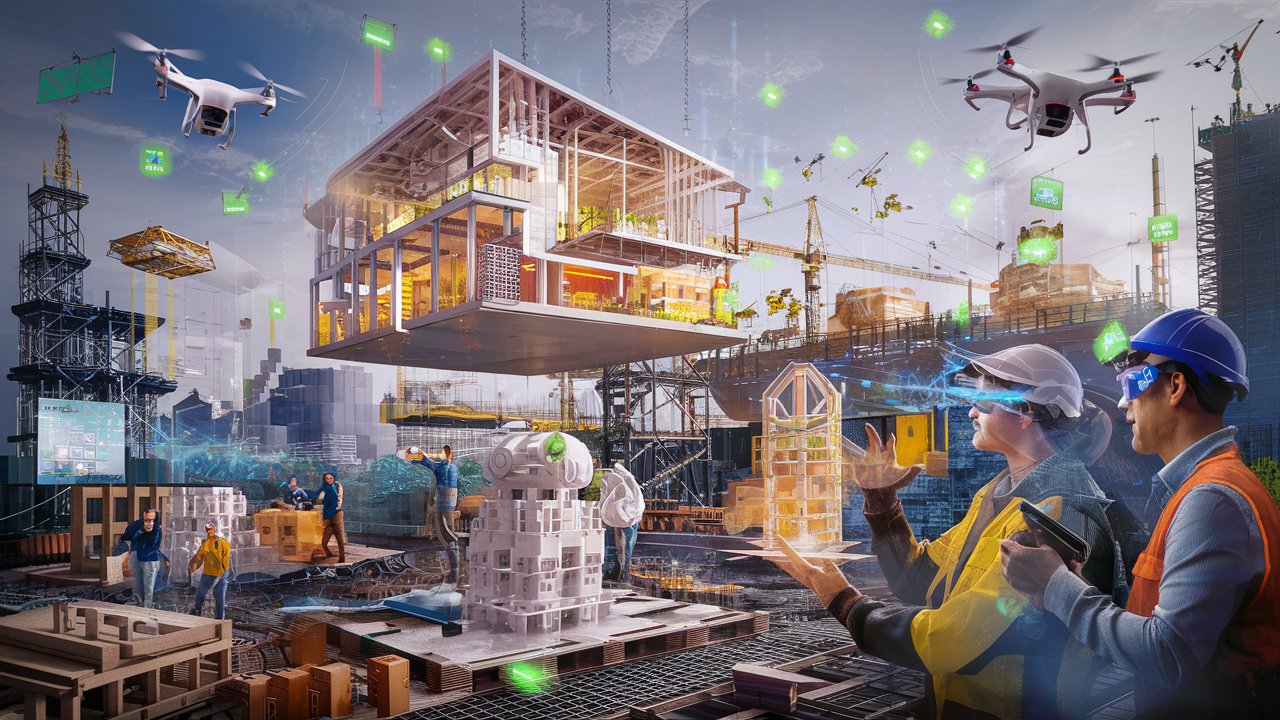Table of Contents
The construction industry is seeing a revolution. It is marked by the use of modern tech. This change is not just about faster building. It’s also about redefining how we build. It is laying the foundation for a new era in construction. It promises better safety, sustainability, and precision. Both dwellings and skyscrapers can attest to this.
Building Information Modeling (BIM): A Collaborative Design Powerhouse

Imagine a tool so powerful. It lets every architect, engineer, and builder work together on a single digital model. That’s Building Information Modeling (BIM). BIM creates detailed 3D models that go beyond mere visuals. They encapsulate functional characteristics, enabling a seamless flow of information. This unity cuts errors and costs. It paves the way for smoother construction. BIM is key to modern construction.
Drones: Taking Flight for Enhanced Efficiency and Safety
The days of hazardous manual site inspections are long gone. With drones taking to the skies, construction sites may now be seen from above. They take high-resolution images and videos. The data they provide is critical for timely decisions and safety improvements. Drones make site inspections faster. They also reduce risks and ensure a full view of projects. They are now essential in construction technology.
3D Printing: Shaping the Future of Construction, One Layer at a Time
3D printing is revolutionizing Construction Technology. It turns designs into reality, one layer at a time. With this technology, intricate, personalized buildings can be created. It cuts waste and costs. 3D printing is pushing the boundaries. It’s happening from whole buildings to tiny details. It’s creating a future where construction is not just about spaces. It’s about crafting them with precision and innovation.
The gap between design and reality is filled by VR and AR.

Virtual and Augmented Reality are changing the Construction Technology industry. They do this by combining digital designs with the physical world. Users are submerged in a virtual reality. AR superimposes digital data over the physical world. With the use of these tools, stakeholders can view and engage with project designs in novel ways. They improve understanding, help communication, and allow for better decisions.
Robotics and Automation: The Rise of the Mechanical Workforce
The future construction site is manned by humans. Additionally, robots and machines staff it. These robots are highly efficient, safe, and precise. They perform anything from data collection to bricklaying. Automation and robotics relieve human workers of dangerous and repetitive tasks. They are reshaping construction. Now, technology and human expertise combine to reach new levels of productivity.
Prefabricated Construction: Building Faster and Smarter
Prefabricated construction is like building with Lego blocks but on a massive scale. Components are manufactured in a factory and then transported to the site for assembly. This method drastically cuts construction time. It also reduces waste, as parts are made to fit. It’s not just about speed; accuracy and productivity are also important. Prefab construction is reshaping the industry. It shows that faster building times don’t have to mean lower quality.
Wearable Technology: Empowering the Modern Construction Worker

Wearable technology on construction sites is like giving workers a superpower. These devices are smart helmets, gloves, and vests. They make safety better, monitor health, and boost efficiency. Imagine a vest that vibrates if a worker is too close to a dangerous area. Also, helmets that can guide a worker with augmented reality. These technologies are empowering workers, and making job sites safer and more productive.
Data Analytics: Optimizing Projects for Success
Data analytics turns mountains of data into actionable insights. In construction, this means analyzing everything from material use to worker productivity. It means finding patterns and inefficiencies. With this information, managers can make smart choices. They can also make operations more efficient and avoid costly delays. It’s about using data to foresee problems and seize opportunities. This ensures projects finish on time and within budget.
Also Read: Flixtor to: Your Guide to Unparalleled Entertainment.
Sustainability in Construction Tech: Building Green for a Better Future
Sustainability in construction is about more than just using eco-friendly materials. It’s about leveraging technology to build in harmony with the environment. This could mean using BIM to cut energy use. Or, drones to assess a project’s impact. The goal is to cut carbon footprints. The goal is to make buildings better for the planet. They should also be healthier for people. It’s a commitment to building a greener, more sustainable future.
The Future of Construction: A Tech-Driven Revolution
Construction’s future will mix innovation, sustainability, and efficiency. It will be powered by technology. Looking ahead, we expect more AI and machine learning. Perhaps, we’ll also see new tech. The future construction site will be safer. It will also be more efficient and eco-friendly. This tech-driven revolution is not just about building better. It’s about reimagining construction for the 21st century.
Final Thoughts
The integration of modern technologies into construction marks the dawn of a new era. These innovations promise to build faster and use fewer resources. They will also transform the very essence of construction. They make work safer. They also make it greener. They create buildings that are both sustainable and innovative. As we use these technologies, we’re not just making buildings. We’re making a better tomorrow.
FAQs:
What is construction technology?
Construction technology refers to the innovative tools, methods, and materials used in the construction industry to improve efficiency, safety, and sustainability in building projects.
How does construction technology impact project timelines?
Construction technology streamlines processes, allowing for quicker project completion through automation, prefabrication, and advanced scheduling techniques, reducing delays and improving overall efficiency.
What are examples of construction technology advancements?
Advancements include Building Information Modeling (BIM), drones for site surveying, 3D printing for rapid prototyping, and smart materials like self-healing concrete, all revolutionizing the way buildings are designed and constructed.




